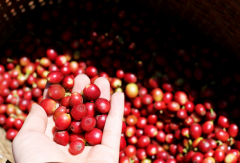Panamanian Coffee, introduced by Ileda Farm in the Balu volcano area of Panama.

Professional coffee knowledge exchange more coffee bean information please follow the coffee workshop (Wechat official account cafe_style)
Panamanian coffee originated in 1780, when European immigrants introduced the first Typica tree species. Located in Central America, with the natural advantages of sunshine, land and mountains, coupled with an adequate working population, the region is an excellent place to grow and produce high-quality and refined coffee, which is a paradise for coffee. In particular, geisha coffee from Panama has led to a global trend of paying attention to boutique coffee, successfully attracting interest in Panamanian coffee in the global market.
Boquete, the oldest and most famous coffee producing area in Panama, is located on the eastern side of Mount Baru, on a plateau of about 1000 to 2000 meters above sea level.
Among them, "Baru Volcano National Park" (Volcan Baru National Park), an ecological conservation area, is very rich in biodiversity and has seven kinds of microclimates. Coupled with the fact that it is shrouded in mist all the year round and abundant rainfall, it has created very good local planting conditions, giving Boguet coffee a unique aroma, making it the producing area with the highest output and the best quality of Panamanian coffee. During the harvest season, coffee farmers will use the delicate method of washing and drying in the sun to make the coffee raw beans full and pure flavor. The Baru volcano is not only the highest mountain in Panama, but the sediments created by early volcanic activity and eruption bring a large amount of fertile soil, which is rich in matter, especially when volcanic ash is rich in phosphorus and sulfur mixed with clay. coupled with unique climate patterns, the region creates an environment suitable for high-quality coffee, dense forests and many species contribute to biodiversity. About 50 coffee farmers here form a small cooperative, all of which produce coffee in the traditional Pocket way-allowing coffee to grow in a near-natural environment. Although the yield is not high, it can maintain a rich ecological environment, and soil quality can be maintained or even improved. The natural planting method is not only beneficial to the environment, but because the coffee fruit grows slowly, it is easier to grow coffee beans of high quality and good flavor.
Farmers harvest ripe coffee berries by hand and send them to nearby Caf é de Eleta S.A. For post-processing, the treatment plant is about 4 kilometers away from the farm, and a modern laboratory is set up for cup test tube and manual screening.
More than half of Pokuid's Eleda Farm is located in Baru Volcano National Park, a protected ecological reserve and sanctuary for exotic plants, as well as birds and mammals (such as tropical tigers). Hunting in this farm has been banned for decades. The Baru volcano is one of the highest volcanoes in Central America, with 14000 hectares and seven different climatic zones at different elevations. Coffee grows only at a height of 1850 meters (6000 feet) in this farm, and Panamanian coffee generally cannot grow above this altitude.
Coffee is produced under these unique conditions for the following reasons: first of all, the farm is located at a very high height (one of the two tallest agricultural gardens in Panama). It grows in rich young volcanic soil and low temperature. there is a lot of fog and light fog in the dry season, and the coffee trees are surrounded by primitive native overcast rainforests. Cooler nights allow coffee trees to spend 4 / 2 to 5 / 2 years in this environment and grow slowly (two or three years longer than the average). These low temperatures also extend the ripening time of coffee beans for a month. All these unique growth conditions give birth to an outstanding and unique coffee cup feeling.
Important Notice :
前街咖啡 FrontStreet Coffee has moved to new addredd:
FrontStreet Coffee Address: 315,Donghua East Road,GuangZhou
Tel:020 38364473
- Prev

Peruvian coffee beans, introduction to Peruvian Fipas Farm Coffee
For more information on coffee beans, please follow the coffee workshop (Wechat official account cafe_style). The Fespanon Garden was set up by Victor Arehundro Garcia in 1960 and continued by Wilder's father, Oracio. Although the third generation of Wilder is only 24 years old, he hopes to participate in the farm organized by professional institutions at the age of 18.
- Next

Introduction to the Santa Ferrisa Manor in Guatemala? What kind do you have?
For more information on coffee beans, please follow the Coffee Workshop (official Wechat account cafe_style). In 1904, Mr.Trinidad E. Cruz founded Santa Ferrisa Manor Guatemala Finca Santa Felisa in Guatemala, which is located in Acatenango, one of the well-known Guardia producing areas. So far, the manor has entered the fourth place.
Related
- Does Rose Summer choose Blue, Green or Red? Detailed explanation of Rose Summer Coffee plots and Classification in Panamanian Jade Manor
- What is the difference between the origin, producing area, processing plant, cooperative and manor of coffee beans?
- How fine does the espresso powder fit? how to grind the espresso?
- Sca coffee roasting degree color card coffee roasting degree 8 roasting color values what do you mean?
- The practice of lattes: how to make lattes at home
- Introduction to Indonesian Fine Coffee beans-- Java Coffee producing area of Indonesian Arabica Coffee
- How much will the flavor of light and medium roasted rose summer be expressed? What baking level is rose summer suitable for?
- Introduction to the characteristics of washing, sun-drying or wet-planing coffee commonly used in Mantenin, Indonesia
- Price characteristics of Arabica Coffee Bean Starbucks introduction to Manning Coffee Bean Taste producing area Variety Manor
- What is the authentic Yega flavor? What are the flavor characteristics of the really excellent Yejasuffi coffee beans?

